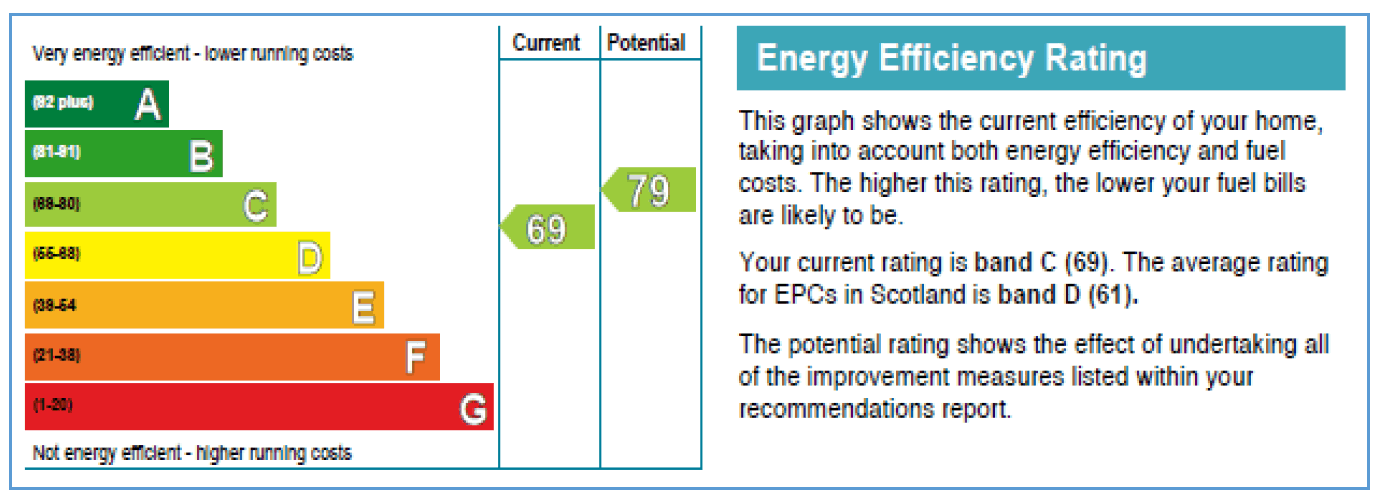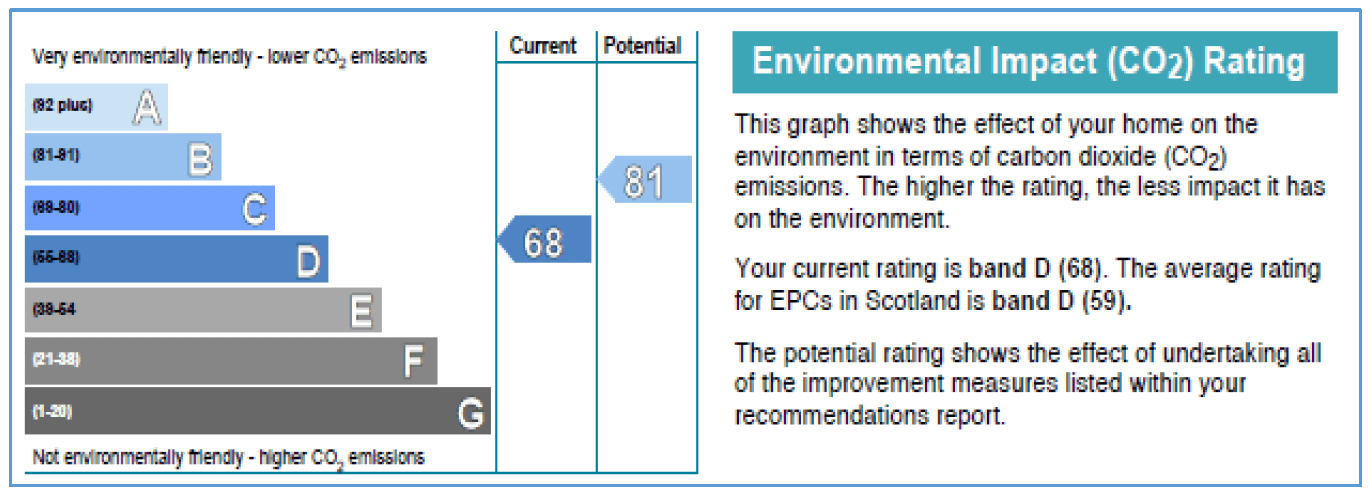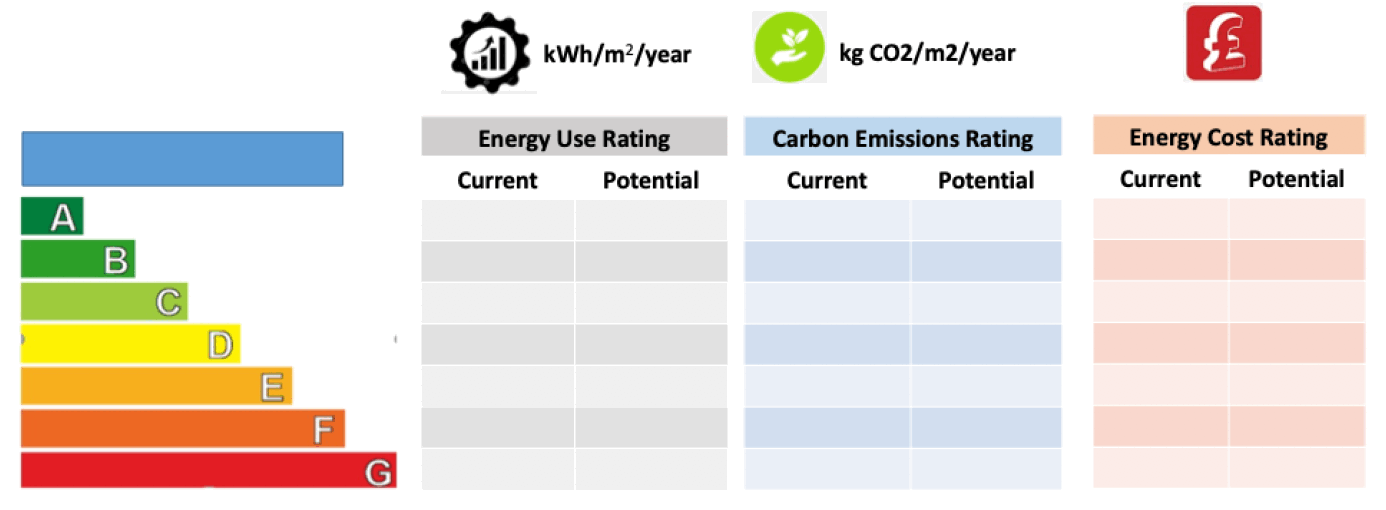Domestic Energy Performance Certificates (EPC) reform: consultation
Consultation setting out proposals to change the Energy Performance Certificates (EPC) format leading on from proposals set out in the draft Heat in Buildings Strategy to reform the EPC framework.
4. Energy Performance Certificate Metrics
4.1 What are EPCs?
Dwelling owners are legally required, under the Energy Performance of Buildings (Scotland) Regulations 2008 to provide an Energy Performance Certificate[14] on construction, sale or rental of a building to a new tenant. These regulations transposed the original European Union's (EU) Energy Performance in Buildings Directive 2002 (EPBD) into Scottish statute and Scottish Government remains committed to our continued alignment of this European directive through the Continuity (Scotland) Act 2020.
The Energy Performance of Buildings (Scotland) Regulations 2008, established two types of EPC – one used for dwellings (domestic) and one for all other building types (non-domestic). The format for each and method of calculation is different for both and is established through these regulations.
This consultation focuses on domestic EPCs and does not include non-domestic EPCs.
The purpose of the EPC is to provide an indication of how energy efficient a building is, including the running costs associated with that, and to provide advice on how the energy efficiency of the building could be improved. On completion, they are valid for a period of 10 years.
Buildings are rated on a scale from A to G, with A being the most efficient and G the least efficient. Information is also provided on measures which could be made to improve the energy efficiency (the Recommendations Report), and an indication of cost and typical savings for each improvement over 3 years.
EPCs are lodged on the EPC register[15]website where single EPCs can be viewed via a public search facility.
The EPC assessment records specific information such as the dwelling type, floor area, construction type, insulation, heating, ventilation and lighting. It also provides a primary energy indicator which is the amount of energy used to produce one kilowatt of power for the household.
The calculation is based on standard assumptions of occupancy and use, and does not take into consideration variations in behaviour of occupants, or the state of repair of the property, and uses a UK-wide calculation methodology[16], managed and implemented by the UK Government with input from the devolved administrations. The EPC assessment process generates a set of suggested improvements and indicates what EPC score might be achieved if these improvements were cumulatively undertaken. This list of recommendations is advisory only and are generated as part of the calculation methodology and software tools used by the EPC assessor.
EPCs for existing dwellings are produced using Reduced Standard Assessment Procedure (RdSAP) – a simplified implementation of the Standard Assessment Procedure (SAP) methodology. RdSAP was developed by government for use in existing dwellings based on a site survey of the property, when the complete data set for a SAP calculation is not available. It consists of a system of data collection together with defaults and inference procedures, defined by the rules in Appendix S of the SAP methodology.
4.2 Information included on an EPC
EPCs display a variety of information to help householders understand the energy performance of their property. They are generated by underlying SAP/RdSAP methodology when a Domestic Energy Assessor (DEA) collects data on a dwelling as part of an assessment. We are not proposing to change SAP/RdSAP methodology or develop any new methodology through this consultation.
SAP/RdSAP is agreed on a UK-wide basis and would require agreement from the other 3 governments to change. We could change the methodology if we choose to, but this would require ongoing development and maintenance of the methodology as a divergent policy too. Rather, we suggest bringing focus to some of the other data gathered, thus presenting a greater range of information to benefit dwelling owners in understanding a range of factors related to energy performance and how improvements to a property influence these factors. The changes proposed remain in line with current EPBD requirements and how energy certification is delivered by EU Member States, reflecting Scottish Ministers' intent to retain alignment with EU provision where practicable.
4.3 Energy Efficiency Rating (EER)

The Energy Efficiency Rating (EER) is the first rating to appear on the EPC. It is well-known and recognisable to most home owners and is required in adverts for sale or rental of properties. It combines information and data including fuel costs to display a band rating in the form of a graph. The graph gives a quick visual comparison of a property's performance similar to the energy labels which appear on home appliances. It provides comparable information on the current rating and the potential rating if recommended improvements were undertaken.
This metric is based on both delivered energy, expressed as kWh/m2/yr, and fuel prices, to provide an energy efficiency rating of a property. Including fuel prices in the calculation for energy efficiency rating causes problems particularly in the cases where some fuels are very expensive and some fuels are considerably cheaper. For example with mains gas, the fuel price is significantly lower than electricity in the data underlying the EPC assessment. This means that mains gas heating systems may achieve a better EER than a zero emissions heating system in an equivalent building. As a result, installing a zero emissions system could lead to a worsening of the rating. As such, the current EPC framework is not compatible with incentivising the uptake of zero emissions heating.
We propose to retain this metric on the revised EPC and clarify its use as an Energy Cost Rating. It will inform dwelling owners and tenants of the indicative impact of the recommended energy efficiency and heating measures on their energy bills. It can also be used to identify those homes where any increase in running costs resulting from moving to zero emissions system cannot be mitigated by improvements to building fabric and act as a signpost for potential government support in those cases.
4.4 Environmental Impact (CO2) Rating (EIR)

The EIR rating is based on carbon emissions and is a measure of the home's impact on the environment in terms of carbon dioxide (CO2) emissions (based on delivered energy kWh/m2/yr and carbon dioxide emissions). The higher the rating the less impact it has on the environment. This rating is based on the performance of the building and its fixed services (such as heating and lighting). The certificate also lists the potential rating of the building if all the cost-effective measures were installed.
As with the EER, information is presented for both the current emissions and potential emissions impact if recommended measures are installed. Further information on the calculated emissions of the property is also set out, in terms of kg CO2/m2/year.
The impact of your home on the environment
One of our biggest contributors to global warming is carbon dioxide. The energy we use for heating, lighting and power in our homes produces over a quarter of the UK's carbon dioxide emissions. Different fuels produce different amounts of carbon dioxide for every kilowatt hour (kWh) of energy used. The Environmental Impact Rating of your home is calculated by applying these 'carbon factors' for the fuels you use to your overall energy use.
The calculated emissions for your home are 43 kg CO2/m2/year.
The average Scottish household produces about 6 tonnes of carbon dioxide every year. Based on this assessment heating and lighting this home currently produces apporximately 2.6 tonnes of carbon dioxide every year. Adopting recommendations in this report can reduce emmisions and protect the environment. if you were to install all of these recommendations this could reduce emissions by 1.1 tonnes per year. You could reduce emissions even more by switching to renewable energy sources.
We propose to continue to use this metric to measure carbon emissions and clarify its use as a Carbon Emissions Rating. This metric will provide an understanding of the carbon emissions associated with heat supply to the dwelling. It can provide an indication for dwelling owners of how energy efficiency measures and heating systems can reduce emissions to zero.
4.5 The Proposal
The proposal is to retain the two metrics set out above and include a third, additional metric - Energy Use Rating (based on SAP Delivered Energy and expressed as kWh/m2/yr[17]). The information required to calculate this rating is already gathered as part of the current EPC assessment and would not require any changes to the SAP calculation methodology. It would simply be expressed more clearly as a direct indicator for the property's current and potential energy demand.
We are proposing to create a new Energy Use Rating which would inform dwelling owners about the energy use of their property[18]. The new metric provides additional information for building owners to complement energy running costs and carbon emissions associated with their dwelling. The new Energy Use Rating can also assist with informed decision by displaying how energy efficiency measures and heating systems can reduce energy use –. Reducing the demand for heat can not only make homes cheaper to heat but prepare a home for zero or low emissions heating systems.
4.6 New EPC Format:
The proposed new format will therefore contain three metrics:
- Energy Use Rating
- Carbon Emissions Rating
- Energy Cost Rating
Energy Use Rating: Provides indicative energy use based on kWh/m2/year. The energy use rating is a new metric on the EPC.
Carbon Emissions Rating:Provides calculated carbon dioxide emissions for a dwelling in kg CO2/M2/year. This metric is the current EPC EIR.
Energy Cost Rating:Provides indicative running costs expressed in pounds per year. This metric is the current EPC EER.

Contact
Email: EPCreform@gov.scot
There is a problem
Thanks for your feedback